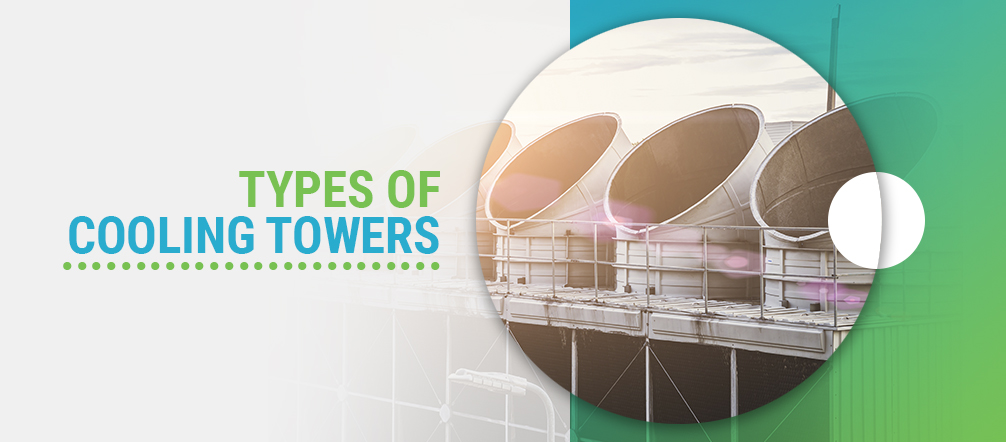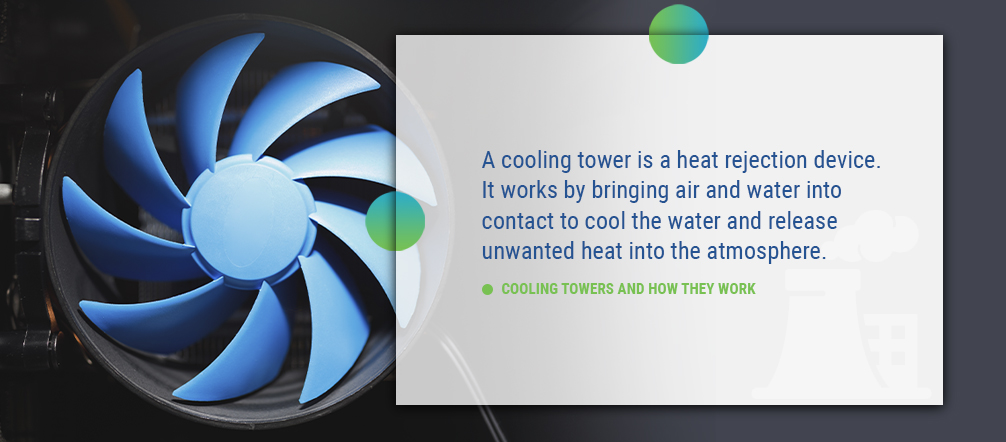
Industrial operations that generate heat utilize cooling towers to cool processes and keep equipment from overheating. Used in various industries, from chemical facilities to thermal power stations, these specialized heat exchangers come in an array of styles with unique designs and functions.
Whether you wish to optimize your commercial HVAC systems with a cooling tower or your manufacturing operations need an effective option for managing heat, let’s explore how these apparatuses work and discuss some of the different types of cooling towers.

Cooling towers are heat exchangers commonly used in air conditioning systems and industrial processes that generate tremendous amounts of heat. The basic operation principle is straightforward — hot water is exposed to cool air, which dissipates unwanted heat into the air through the process of evaporation. This keeps industrial environments cool and reduces the risk of mechanical breakdowns due to overheating and dangerous heat or fire hazards.
Cooling towers come in a variety of sizes. Some are as small as a few square feet, and others are industrial-sized devices. The different sizes enable different load configurations.
Cooling towers all perform the same primary function — to increase the surface area over which water and air interact. A larger surface area means more efficient evaporation — and more efficient evaporation means faster cooling.
How does that process work? The key steps in a cooling tower process are:
Cooling towers contain various components that work together to circulate water and air through the apparatus. Below are a few essential components of many cooling towers.
Fill media is the main heat transfer surface. The area often features ridges with open spaces to optimize water-to-air contact, facilitating faster heat transfer. Today’s fill surfaces or wet decks are frequently made of textured polyvinyl chloride (PVC) plastic.
Fill can come in a couple of different types:
Though not all cooling towers require fans, many models use them to create and direct airflow through the tower. These motorized mechanisms push or pull air through the tower, utilizing axial or centrifugal designs depending on the specific needs of the application. Axial fans are more efficient, whereas centrifugal fans are quieter and can deal with higher levels of static pressure.
There are two types of distribution systems usually employed by cooling towers — a pressurized spray system or a gravity system.
Spray distribution systems increase water surface area in some cooling towers, such as counterflow towers. Spray nozzles mounted inside the tower disperse water droplets into the air to ensure uniform water distribution.
Gravity distribution systems are often used in crossflow cooling towers. A distribution basin takes the place of the spray nozzles by distributing the hot water evenly throughout the tower. It sits atop the tower and typically consists of a pan with holes or nozzles along its base. Hot water flows in through the top of the tower, and the holes or nozzles release it evenly over the fill material below.
The collection basin sits at the bottom of the cooling tower and collects water after it has cooled. In field-built models, these basins are often made of concrete to support the tremendous weight of the water coming down the tower.
Sumps are a separate tank large enough to supply water to fill the entire recirculation system. Waste sumps are optional containers that receive all cooling tower drains and overflows, connecting wastewater to the sewer.
There are numerous types of cooling towers with unique designs that use different techniques to cool processed water. These towers are categorized based on several factors, such as:
While a cooling tower may fall into multiple categories, here are the five main types of cooling towers for HVAC and industrial processes.
Crossflow cooling towers are named because of how air enters the apparatus — from the sides. The crossflow action allows incoming air to flow horizontally across the fill media. At the same time, gravity sends hot water flowing down from distribution basins that sit atop the tower.
Crossflow cooling towers offer the advantage of great height, and they are some of the most cost-effective and simplest models to maintain. They can use smaller pumps because they use gravitational force to aid air-to-water contact. And because their spray is non-pressurized, they allow for more variable water flow.
Crossflow designs are more at risk of freezing and clogging from dirt or debris, especially in high-wind, dusty areas.
EVAPCO’s AXS cooling towers are good examples of induced draft crossflow towers.
Named for the air and water entering from different ends of the tower, a counterflow cooling tower allows water to flow down from the top while air moves vertically across the fill — from the bottom of the tower to the top. Because the airflow is upward, counterflow towers cannot use gravity-flow basins, so these towers use pressurized spray nozzles to distribute the water over the splash fill.
Counterflow towers are more modest in size than crossflow towers, which means they can sometimes provide greater efficiency. And because of their spray function, they offer more resistance to freezing than crossflow towers. The extensive surface area of the large volume of spray they produce also makes heat transfer more efficient.
This type of cooling tower requires greater energy expenditure and larger pumps, as air is pushed against the flow of water. This exertion can lead to increased utility bills. Counterflow towers sometimes struggle with variable water flow because it can impede the tower’s spray characteristics. They can often be noisier than their crossflow counterparts because the water has farther to fall from the bottom of the fill into the basin.
BAC’s Series V cooling towers are good examples of counterflow towers.
Unlike mechanical cooling towers, such as induced and forced draft models, natural draft cooling towers utilize natural convection to provide adequate airflow.
Natural draft towers often feature steep chimney architecture to enhance the natural vertical flow of air. Cold, dry air comes through the tower’s top and mingles with warm, moist air within the tower. This movement creates a constant pattern of air circulation that helps cool water and release heat.
One example of a natural draft cooling tower that offers numerous benefits is the hyperbolic tower with a chimney-like design. Hyperbolic towers provide numerous benefits. Their hyperbola shape helps direct airflow upward, enhancing their efficiency. They also typically offer impressive structural integrity and strength while requiring only modest amounts of materials in their construction.
ENEXIO manufactures good examples of natural draft cooling towers.
Induced draft cooling towers utilize mechanical means — such as fan systems — to transfer air through the tower. They get their name from the induction of warm, moist air from the discharge outlet. An induced draft tower typically has fans at the tower’s top acting as an air outlet that pulls cooler air through the apparatus.
One of the benefits of an induced draft cooling tower is that air moves at such high velocity upon exiting that it prevents unwanted recirculation.
EVAPCO’s AT cooling towers and SUN cooling towers are good examples of induced draft counterflow towers, as are BAC’s PT2 cooling towers.
A forced draft tower is similar to an induced draft tower, but the placement of its fans is different. A forced draft tower typically has fans in the air intake rather than the air outlet. Instead of pulling the air, these fans, which are located on the sides of the tower’s base, push the air directly into the tower.
Forced-draft cooling towers take air in at a high velocity but tend to discharge it at a lower velocity since friction slows the air as it passes through the tower. This lower velocity means forced-draft towers are more susceptible to undesirable air recirculation. Their design also makes them costlier and more inefficient to run because they require more power.
Forced draft cooling towers are especially beneficial for small-scale, indoor applications, as they tolerate high pressure exceptionally well.
EVAPCO’s LSTE cooling towers and LPT cooling towers are good examples of forced draft counterflow towers.
Another way to differentiate cooling towers is by categorizing how they were assembled — factory-assembled versus field-erected. Cooling towers may be constructed in the production factory and then shipped to your operation, or workers may assemble the towers at your site.
No matter what type of cooling tower your operations use, following a strict preventative maintenance plan is essential. Regular maintenance prolongs your cooling tower’s life span, ensuring you get the most return on investment, and defends it against some of the most common contamination issues, such as biological growth, scaling, fouling and corrosion.
If you want to keep your cooling tower running efficiently, here are some regular cooling tower maintenance tips:
Click here for part 2, which focuses on the efficiency of each type of cooling tower.
Whether you have a crossflow, counterflow, natural draft, induced draft or forced draft cooling tower, it will likely require cleaning at some point. Keeping your cooling tower clean and well-maintained is essential for several reasons. It helps prevent scale and corrosion, and it helps prevent and control the accumulation of microorganisms that could spread illnesses like Legionella. Effective cleaning and maintenance help increase your facility’s efficiency, reduce repair frequency, save money and prevent catastrophic breakdowns and disease outbreaks.
To see the benefits of chemical water treatment for your cooling tower, make Chardon Labs your trusted provider. Our extensive years of experience and industry expertise mean we can select the chemicals necessary to get your cooling tower operating at peak performance. We’ll provide a complimentary assessment of your current system, deliver and add the chemicals, dispose of the containers safely and provide ongoing maintenance at a fixed yearly price that eliminates surprise bills.
Contact us today to learn more.